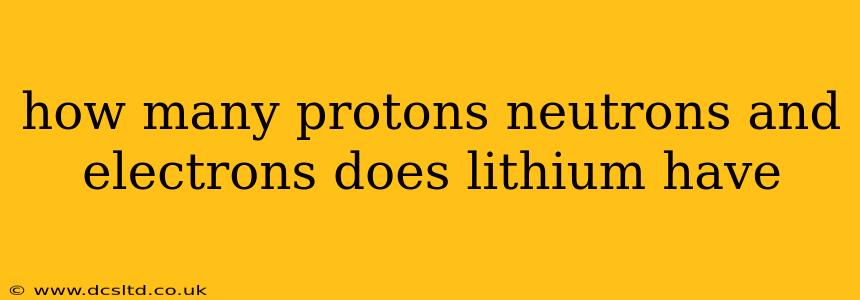Lithium, a fascinating alkali metal, holds a unique position in the periodic table. Understanding its subatomic composition is key to grasping its chemical properties and behavior. This post will delve into the number of protons, neutrons, and electrons found in a lithium atom, along with addressing some common related questions.
What is the Atomic Number of Lithium?
Before we dive into the specifics, let's establish a fundamental concept: the atomic number. This number, unique to each element, represents the number of protons in the nucleus of an atom. Lithium's atomic number is 3. This means every lithium atom contains 3 protons.
How Many Electrons Does Lithium Have?
In a neutral atom—meaning it doesn't carry an overall electric charge—the number of electrons equals the number of protons. Therefore, a neutral lithium atom has 3 electrons.
How Many Neutrons Does Lithium Have?
Determining the number of neutrons requires considering isotopes. Isotopes are atoms of the same element with the same number of protons but a different number of neutrons. Lithium has two naturally occurring stable isotopes:
- Lithium-6 (⁶Li): This isotope has 3 protons and 3 neutrons (6 - 3 = 3).
- Lithium-7 (⁷Li): This isotope has 3 protons and 4 neutrons (7 - 3 = 4).
The number shown as a superscript (e.g., the 6 in ⁶Li) represents the mass number, which is the total number of protons and neutrons in the nucleus. Therefore, the number of neutrons in lithium varies depending on the isotope. The most abundant isotope is Lithium-7.
How Many Protons, Neutrons, and Electrons are in Lithium-6?
- Protons: 3
- Neutrons: 3
- Electrons: 3 (in a neutral atom)
How Many Protons, Neutrons, and Electrons are in Lithium-7?
- Protons: 3
- Neutrons: 4
- Electrons: 3 (in a neutral atom)
What is the Electron Configuration of Lithium?
Understanding the electron configuration helps visualize how electrons are arranged within the atom. Lithium's electron configuration is 1s²2s¹. This means that two electrons occupy the first energy level (1s orbital), and one electron occupies the second energy level (2s orbital). This outermost electron is readily available for bonding, giving lithium its reactive nature.
Why is the Number of Neutrons Variable in Lithium?
The number of neutrons can vary because neutrons contribute to the atom's mass but not its charge. Different numbers of neutrons result in isotopes, which have slightly different masses but retain the same chemical properties. The variations in neutron number are due to the nuclear forces within the atom.
In conclusion, while the number of protons and electrons in a neutral lithium atom is always 3, the number of neutrons can be 3 (in Lithium-6) or 4 (in Lithium-7), depending on the isotope. This fundamental understanding of lithium's subatomic structure is crucial for comprehending its behavior in various chemical and physical processes.
